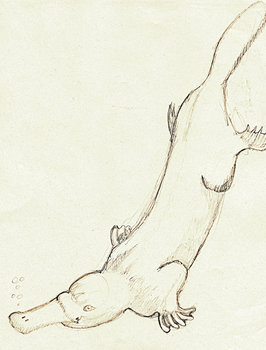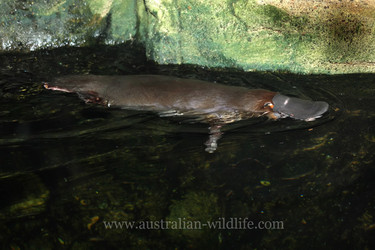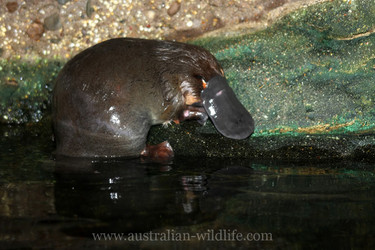Scientific Name: Ornithorhynchus anatinus
Common Name: Platypus


Ornithorhynchus anatinus. © Adam Gadawski
General Description
The platypus is an egg laying, carnivorous mammal. It is a medium sized animal that weighs between 1 kg and 2 kg on average and ranges between 40 cm and 55 cm in length. It has a duck-like bill, short brown fur, webbed feet and a fairly wide, flat tail. The platypus is a monotreme and like most other monotremes, has a body temperature of 32 degrees Celsius. It is also nocturnal or more specifically, crepuscular (active at dawn and dusk). The males have a venomous spike on each hind leg which is used for defensive purposes. The platypus swims with its eyes, ears and nostrils closed so it uses electrolocation to sense moving objects around it.
Specific Habitat
The platypus can only be found in Australia. It is most commonly found in all sorts of fresh water streams including alpine creeks and lowland rivers but can also inhabit lakes, farm dams and reservoirs. It generally lives near a steep, vegetated bank in which it can burrow. The burrows are generally shallow, but females can create burrows up to 20 metres deep for breeding purposes.
Specific Adaptations to the Environment
Over time, the platypus has made two very important adaptations that allow it to hunt effectively. First, its electrolocation ability makes up for the fact that it can’t see, hear or smell anything in the water when it swims. This ability allows the platypus to detect the small electric impulses given off by animals when they move. Second, it uses its bill to stir up the bottom of the stream, forcing its prey to move.
Reproductive Habits
Platypuses reproduce in early spring/late winter. The female can lay 1-3 eggs but usually ends up laying 2. The female curls around the eggs to incubate them until they hatch while the male leaves and has nothing to do with caring for the offspring. When they finally do hatch, the babies stay in the burrow for 3 to 4 months and feed on milk from their mothers. Unlike most other mammals, the milk is secreted from the skin of the mother since platypuses do not have nipples. During the 3 to 4 months, the mother leaves only for short increments of time, and when she does, she blocks off the burrow. The offspring leave after this period.


Ornithorhynchus anatinus swimming out of its burrow. Image © Australian Wildlife.
Classification
- Kingdom: Animalia
- Phylum: Chordata
- Class: Mammalia
- Order: Monotremata
- Family: Ornithorhynchidae
- Genus: Ornithorhynchus
- Species: Ornithorhynchus anatinus
Importance of the Organism to the Ecosystem:
Since the platypus is a carnivore, it plays the typical role of the carnivore in an ecosystem. It keeps the populations of species in lower levels of the food chain in check.
Common or Endangered?
The platypus is a fairly common animal in Australia although it is listed as “near threatened” due to water pollution. Also, more recently, a fungal disease has started migrating from the mainland to Tasmanian populations. Platypuses in the mainland had developed an immunity to this disease but in Tasmania, it is killing about 35% of animals in affected populations.


Ornithorhynchus anatinus on a river bank. Image © Australian Wildlife.
The Adventures of Pluto the Platypus
- You have just escaped from the zoo and are free in Australia. To return to your homeland, your choices are to go to Eastern Queensland or South Australia.
- If you would like to go to Eastern Queensland go to [2]
- If you would like to go to South Australia go to [3]
- Congratulations! You have found your way home. Enjoy swimming and basking in your homeland.
Go to paragraph [4] to continue with the adventure that is your life. - Oops! Looks like you do not know what is best for you. Please read more about yourself in the information above. South Australia does not have the proper climate and ecosystem for you, so your stay was short-lived. It’s survival of the strongest out there and sadly you can not compete here.
If you would like to try your luck again, I suggest you brush up on your knowledge of Ornithorhynchus anatinus. Go back to paragraph [1] if you would like to try again. - Now that you’re back you can pick a nice spot to set up your den. Australia, the land of opportunity. Where to go - there is the beach front property, a nice cattle ranch, perhaps, or maybe a little river.
- Beach front for me, the beautiful ocean, and all those colorful fish -Yum, Yum! [5]
- It’s the ranch for me, dry weather helps my lungs. [6]
- A nice little river, perhaps with a small pond is best suited for me. [7]
- Salt water does not seem to be helping you and in your disorientation you are eaten by a shark.
- With the lack of water you lose much of your advantage over prey, and are a slow moving target for wild dogs. Better luck next time.
- Congratulations! You made it to your river habitat. After a long journey you are hungry as a platypus, which as I am sure you are aware eat 20% of their body weight a day. Time to go hunting for some grub and small fish, but evolutionarily blessed as you are, you have two possible methods to hunt.
- If you would like to go up to your prey and inject it with venom –how could venom not work- go to [8].
- If you would like you could use electrolocation by locating your prey using electric fields generated from the motion of other organisms around you, go to [9].
- While the venom can be potent on small animals, it is mostly used to drive other male platypus away from your mate. You are experiencing small amounts of success using this method, since your venom is in a spur on your hind legs, you must flip around to poison the animal, giving it lots of time to get away.
- This is hopeless I am never going to catch anything, I quit. I will just sleep somewhere. [10]
- Continue hunting this way, never give up! [11]
- Go with electrolocation to find your prey. [9]
- Perfect choice, this allows you to locate prey around you and hunt them down with precision. Tonight you will feast on shrimp, insect larva and annelid worms. Continue to [10] to look for a home
- Time to go find a snug little home, but there is so much choice, and what is best for a young platypus.
- I hunt underwater, therefore I live underwater, I will choose a burrow underneath the river. [13]
- I could just lie down on my back, and pretend that I don’t have predators. [14]
- Perhaps a burrow would be the best place for me, away from predators, but still giving me air to breath. [15]
- A platypus requires large amounts of food to survive, with that lacklustre hunting, there is no way you could survive for long, please try again.
- Finally after hours of hunting you catch enough food. Exhausted you start to look for a home. [10]
- Sadly you can not live underwater, and after a minute you realize that and surface, time to continue to look for a home. [10]
- You curl up and fall asleep. Sadly you never wake up, it will always be a mystery as to what got you. Please try again.
- Yes, a burrow is just perfect. No predators anywhere to be seen, close to your source of food, the river, and nice and snug to curl up in. Congratulations, you have made it through your first night.
- Please go to [16] to continue
- Morning has arrived. Good thing it’s cloudy out, as platypus often only hunt nocturnally or when the sky is clouded, it will take you a few days to adjust to your new schedule. When you walk out of your burrow, you think you see a shadow flit over you.
- It was nothing, what could worry you, mighty Pluto the Platypus [17]
- You have an uncertain feeling, and rush to the water and dive in, better to be safe than sorry. [18]
- As you go at a leisurely pace to the water you can’t shake the sensation that something is watching you. As you are about to turn around you hear a ferocious screech, and out of nowhere comes an eagle. Your adventures end here, but please try again.
- Good thing you listened to instinct, evolution has served you well. You are highly evolved, not half reptilian like early scientists thought, but pure Mammalia. You spend the rest of the day eating the 20% of your body weight that it takes to survive.
CONGRATULATIONS! YOU SURVIVED THE ADVENTURES OF PLUTO THE PLATYPUS
Information on the Internet
- Platypus Australian Wildlife. Accessed 15 Sept. 2008.
- Platypus (Ornithorhynchus anatinus) Australianfauna.com. Accessed 16 Sept. 2008.



 Go to quick links
Go to quick search
Go to navigation for this section of the ToL site
Go to detailed links for the ToL site
Go to quick links
Go to quick search
Go to navigation for this section of the ToL site
Go to detailed links for the ToL site